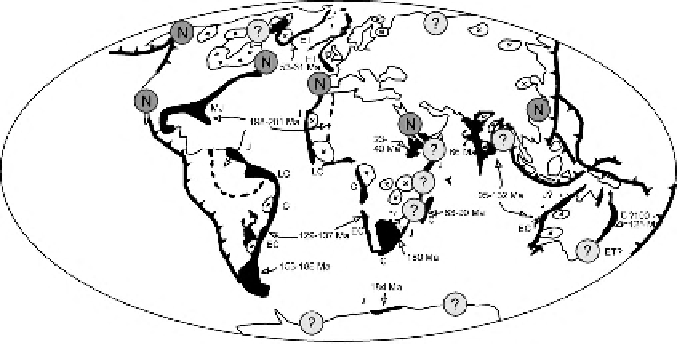Geoscience Reference
In-Depth Information
major hydrocarbon reservoirs. Figure 9.4 shows that sediment thickness increases
rapidly with distance from the coast locally, beneath the continental shelf, reach-
ing a thickness of more than 10 km. This is considerably greater than the thickness
of sediment on old oceanic crust. The subsidence rates in these
syn-rift basins
,
as recorded in the sedimentary record, decrease with time since rifting. The crust
beneath these basins is extensively cut by normal faults, which have been imaged
clearly by reflection profiling. These faults are often observed to be
listric faults
,
faults for which the angle of dip decreases with depth.
To explain these continental-margin sedimentary basins, it is necessary to
consider the effects of stretching the lithosphere and so allowing hotter astheno-
spheric material to rise. The first effect of such stretching is isostatic: lithospheric
material is replaced by asthenospheric material, and, depending on the thicknesses
and densities, subsidence or uplift ensures that isostatic equilibrium is reattained.
The second effect is thermal: the stretched lithosphere and asthenosphere are not
in thermal equilibrium. Cooling, and hence slow contraction and further subsi-
dence, takes place until a new thermal equilibrium is eventually reached. Thus,
the sedimentary basins develop as a direct consequence of the stretching, cooling
and subsidence of the lithosphere. Stretching models can also be used to explain
continental-margin sedimentary deposits formed during continental rifting and
some extensional basins that formed when continental lithosphere was stretched,
but did not split.
Results of detailed seismic studies combined with ocean drilling have shown
that there are two types of passive continental margins -
volcanic
and
non-
volcanic
(Fig. 10.41). Volcanic rifted margins are those associated with a sig-
nificant amount of mantle melting, with volcanism occurring either immediately
prior to, or during, the process of continental break-up. In contrast, non-volcanic
margins form with no associated melting of the mantle. Adiabatic decompression
Figure 10.41.
Global
distribution of rifted
margins younger than
200 Ma; volcanic (solid
black), non-volcanic (N)
and unknown (?) - 90% of
continental margins are
volcanic. The approximate
age of the oldest oceanic
crust is shown as well as
the age of the continental
flood basalts (J, Jurassic;
C, Cretaceous; T, Tertiary -
prefixes E, M and L denote
Early, Middle and Late).
⊗
,
Archaean cratons. (From
Menzies
et al
.(2003).)

